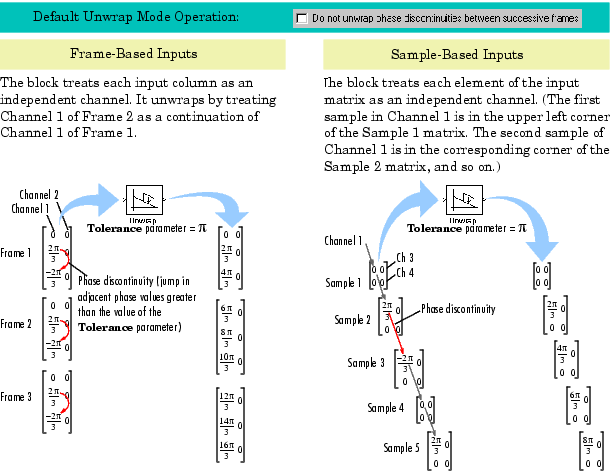

| DSP Blockset |   |
Library
Description
The Unwrap block unwraps each input channel by adding or subtracting appropriate multiples of  to each channel element. The input can be any matrix or 1-D vector, and must have radian phase entries. The block recognizes phase discontinuities larger than the Tolerance parameter setting.
to each channel element. The input can be any matrix or 1-D vector, and must have radian phase entries. The block recognizes phase discontinuities larger than the Tolerance parameter setting.
The block preserves the input size, dimension, and frame status, and the output port rate equals the input port rate. For a detailed discussion of the Unwrap block, see other sections of this reference page.
Sections of This Reference Page
Acceptable Inputs and Corresponding Output Characteristics
The Unwrap block preserves the input size, dimension, and frame status, and the output port rate equals the input port rate.
| Characteristics of Valid Input |
Characteristics of Corresponding Output |
The Two Unwrap Modes
You must specify the unwrap mode by setting the parameter, Do not unwrap phase discontinuities between successive frames. The unwrap modes are summarized in the next table.
In both unwrap modes, the block adds  to each input channel's elements, where it updates k at each phase discontinuity. (For more on the updating of k, see Unwrap Method.) The number of times that k is reset to 0 depends on the unwrap mode. to each input channel's elements, where it updates k at each phase discontinuity. (For more on the updating of k, see Unwrap Method.) The number of times that k is reset to 0 depends on the unwrap mode. | |
| Default Unwrap Mode: Initialize k to 0 For Only the First Input Frame |
Nondefault Unwrap Mode: Set k to 0 For Each Successive Input Matrix or Input Vector |
|
In this mode, k is initialized to 0 for only the first input matrix or input vector. As k gets updated, the value of k is retained between successive input matrices or input vectors. That is, the block unwraps each input's channel by considering phase discontinuities in all previous frames and the current frame. |
In this mode, k is reset to 0 for each successive input matrix or input vector. As k gets updated, the value of k is only retained within the current input matrix or vector. That is, the block unwraps each input's channel by considering phase discontinuities in the current input matrix or input vector only, ignoring discontinuities in previous inputs. |
| In this mode, the block unwraps the columns or each individual element of the input: |
In this mode, the block unwraps the columns or rows of the input: |
| See the following diagrams. |
See the following diagrams. |
The following diagrams illustrate how the two unwrap modes operate on various inputs.

Unwrap Method
The Unwrap block unwraps each channel of its input matrix or input vector by adding  to each successive channel element, and updating k at each phase jump. See the following steps to the unwrap method for details.
to each successive channel element, and updating k at each phase jump. See the following steps to the unwrap method for details.
| Relevant Unwrap Terms: |
|
| Steps to the Unwrap Method: |
|
Definition of Phase Unwrap
Algorithms that compute the phase of a signal often only output phases between  and
and  . For instance, such algorithms compute the phase of
. For instance, such algorithms compute the phase of  to be 3, since
to be 3, since  , and since the actual phase,
, and since the actual phase,  , is not between
, is not between  and
and  . Such algorithms compute the phases of
. Such algorithms compute the phases of  and
and  to be 3 as well.
to be 3 as well.
Phase unwrap or unwrap is a process often used to reconstruct a signal's original phase. Unwrap algorithms add appropriate multiples of  to each phase input to restore original phase values, as illustrated in the following diagram. For more on phase unwrap, see the previous section, Unwrap Method.
to each phase input to restore original phase values, as illustrated in the following diagram. For more on phase unwrap, see the previous section, Unwrap Method.
Dialog Box
 (rather than a smaller value) to avoid altering legitimate signal features. To increase the block's sensitivity, set Tolerance to a value slightly less than
(rather than a smaller value) to avoid altering legitimate signal features. To increase the block's sensitivity, set Tolerance to a value slightly less than  .
.Supported Data Types
To learn how to convert to the above data types in MATLAB and Simulink, see Supported Data Types and How to Convert to Them.
See Also
unwrap |
MATLAB |
Also see Signal Operations for a list of all the blocks in the Signal Operations library.
 | Uniform Encoder | Upsample |  |